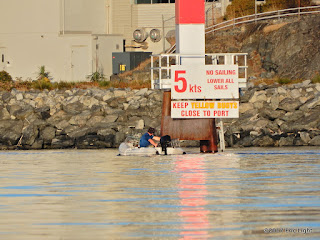Port of Victoria entry instructions
Of course, when a vessel enters Victoria Harbour it's expected that the captain will have checked their charts and noticed that the main part of the harbour is an aerodrome.
To keep everyone out of the flight paths, there's a line of yellow buoys along the south side of the harbour. The drill is that you keep the yellow buoys to port, such that they act as a highway centreline. The north side of the harbour has a few white buoys. Non-powered vessels (kayaks, etc.) are expected to use the north side, but are not strictly relegated there. Here's a screen shot from the Navionics web app. I've gone over the green lines outlining the airodrome, as they were very faint. The purple lines show the roadway for power vessels. The little harbour ferries can go on either side.
Here's the new sign on the new fixed beacon at the harbour entry, off Shoal Point in the above diagram (Coast Guard station in the background):
Gearing up for a spill
I've seen a number of different spill response vessels around the harbour recently. This is the most colourful.
Like a bird on a wire
Starlings over boat work at the Point Hope shipyard:
It must get right hot in there! At least their sanding dust, etc., doesn't fly around the neighbourhood. Yes, there's a ship under there!


















































